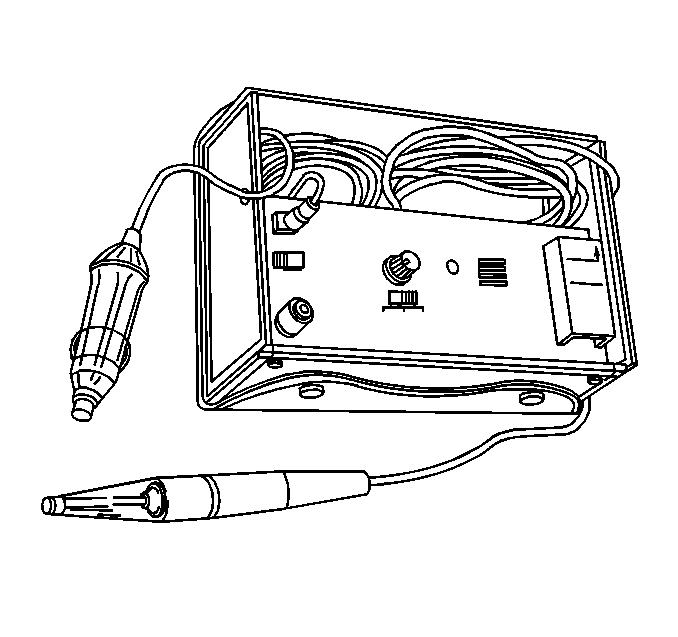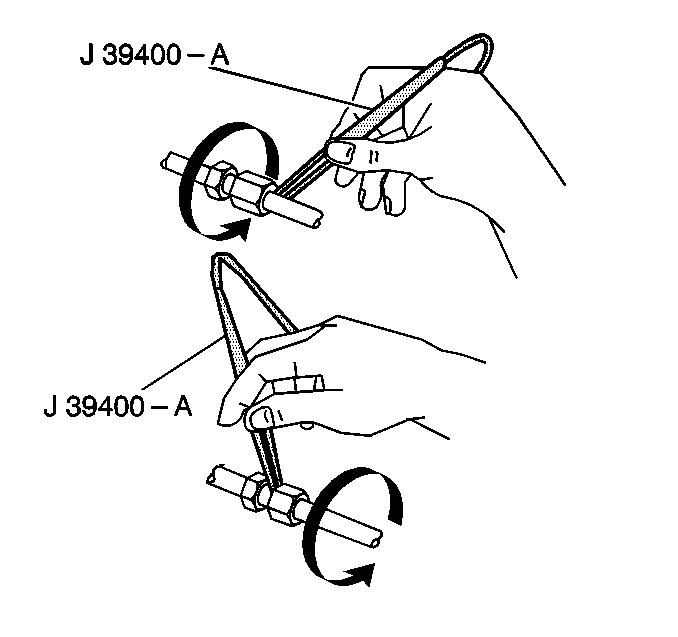Caution: Do not operate the detector in a combustible atmosphere since its sensor operates at high temperatures or personal injury and/or damage to the equipment may result.
Caution: Avoid breathing the A/C Refrigerant 134a (R-134a) and the lubricant vapor or the mist. Exposure may irritate the eyes, nose, and throat. Work in a well ventilated area. In order to remove R-134a from the A/C system, use service equipment that is certified to meet the requirements of SAE J 2210 (R-134a recycling equipment). If an accidental system discharge occurs, ventilate the work area before continuing service. Additional health and safety information may be obtained from the refrigerant and lubricant manufacturers.
Perform a refrigerant leak test on the system whenever you suspect a leak, or following any service operation that disturbs the components, the lines, or the connections. Many methods and special tools are available for this purpose. However, no matter which tool is used, care and diligence are the biggest keys to success.
Electronic Leak Detector
Tools Required
J 39400 Electronic Leak Detector

This type of leak detector is the most useful tool in locating refrigerant leaks. The J 39400 is a small tool that operates on 12V DC. The J 39400 provides an audible signal that increases in frequency as R-134a is detected. Make sure the instrument is properly calibrated according to the included instructions. Use the refrigerant in the proper setting for the type of refrigerant being tested. Place the detector GAS switch in the R-134a setting prior to use.
Leaks are most commonly found at the refrigerant fittings or connections. These types of leaks are often caused by the following conditions:
| • | Improper torque |
| • | Damaged O-ring seals |
| • | Lack of lubricant on the O-ring seals |
| • | Dirt and debris across the O-ring seals |
Even the smallest piece of lint from cotton gloves or shop cloths can create a leak path across an O-ring seal.

Important: The halogen leak detectors are sensitive to windshield washing solutions, many solvents and cleaners, and some adhesives used in the vehicle. Prevent a false warning by making sure the surfaces are clean. Also, the surfaces should be dry, because the ingestion of liquids damages the detector.
The successful use of this or any other electronic leak detector depends greatly upon the scan rate. Follow the manufacturer's instructions carefully regarding calibration, operation, and maintenance.

Circle each joint completely. Move the probe at 25-51 mm (1-2 in) per second, keeping the tip of the probe as close to the surface as possible. The probe should be no more than 6 mm (0.25 in) away from the surface. Do not block the air intake. The detector ordinarily emits an audible tone of 1-2 clicks per second. However, if a leak is present, the detector sounds a solid alarm. Adjust the balance knob on the detector frequently to maintain the rate of 1-2 clicks per second. The following areas may be tested using this procedure:
| • | The evaporator inlet and outlet |
| • | The accumulator inlet and outlet |
| • | All brazed and welded areas |
| • | Hose couplings |
| • | The compressor rear head |
| • | The housing joints |
| • | Any area showing signs of damage |
Test Procedure
Caution: Take care to prevent personal injury which could occur due to touching a hot engine when testing. Tests should be done with the engine "Off" and as cool as possible. Do not operate the detector in a combustible atmosphere since its sensor operates at high temperature.
Important: Always follow the refrigerant system around in a continuous path, so that no areas of potential leaks are missed. Always test all of the areas mentioned to ensure that the entire system is leak-free, even when one leak is already found.
Service Ports/Access Valves
The primary seal for the service ports is the sealing cap. This cap contains a special O-ring seal or gasket designed to provide a leak-free seal. If the sealing cap is loose or missing, or the wrong cap is used, a loss of the refrigerant charge will result.
Evaporator Core
Finding leaks in the evaporator core is very difficult. Leak test the core as follows:
- Turn the blower fan to the HIGH position for 15 seconds or longer.
- Wait 10 minutes.
- Remove the blower motor resistor. Refer to Blower Motor Resistor Replacement .
- Insert the leak detector probe as close to the evaporator as possible.
- If possible, visually inspect the core face with a flashlight for evidence of refrigerant oil.
Then, turn the blower fan OFF.
The detector will sound a solid alarm if a leak is found.
Compressor Block Fitting and Shaft Seal
Test the compressor block fittting and shaft seal as follows:
- Blow shop air behind and in front of the compressor clutch/pulley for at least 15 seconds.
- Wait 5 minutes.
- Probe the area in front of the pulley.
A solid alarm indicates the discovery of a leak.
